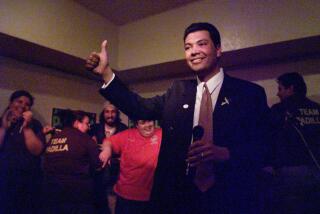Overlays and Splits
- Share via
Re “Revised Bill Cuts Focus on 310 Overlay,” Sept. 10.
What furor in 818?
The Times consistently reports that a “furor” has developed in both the 818 and 310 area codes over the pending area code overlays. This is certainly true in the 310, on Los Angeles’ Westside. However, to claim that the anti-overlay passion has spilled over the hill and into the San Fernando Valley is, at best, a stretch.
Since the overlay was first proposed a year ago, several public meetings have been held in the Valley to discuss the CPUC’s [California Public Utilities Commission’s] pending decision. At the initial public meetings on the matter, half of the citizen comments came in support of an overlay for the Valley--14 comment cards supported the overlay; 14 came in support of all possible configurations for splitting the Valley’s 818 area code.
When Assemblymen [Wally] Knox and [Antonio] Villaraigosa held a public hearing on the Westside in late August, as many people attended that one meeting as there have been at all of the public forums on the issue hosted in the Valley by state Sen. [Richard] Alarcon, the Valley Industry and Commerce Assn. (VICA) and others. Those who came out to protest an overlay in the Valley were from the cities of Burbank and Glendale--which would keep the 818 area code if it were split.
If there is a public outcry in the Valley, it is in opposition to a split of the 818 and in support of the overlay. Not only is an overlay the only fair and equitable option for area code relief in the Valley, it also recognizes one fact: The Valley is, in and of itself, one community of interest.
Perhaps splitting the Valley--if only its area code--is what the political elite south of Mulholland would like to see. If there is any public furor in the Valley, it should be to rise against those who want to split us apart.
SCOTT OLIN SCHMIDT
VICA Government Liaison Director
Encino
* We have had enough of splitting or overlaying area codes. The telecommunications industry should be using a 12-digit system instead of the decimal system now in use. Telephone dials already have two additional symbols--[the star and pound signs]. Using just one of these symbols in just one position would double the number of numbers available. Using both symbols in one or more positions would yield so many numbers they would never again have to split area codes. A telephone number could be something like 55*-1234 or 555-#123 or 588-1#*2.
These symbols appear on every keyboard and are easy to write. If the problem is the few rotary dial telephones still in use, those who have rotary telephones could use operator assistance when calling a number with one of these symbols.
MARY S. MORGAN
West Hills
More to Read
Get the L.A. Times Politics newsletter
Deeply reported insights into legislation, politics and policy from Sacramento, Washington and beyond. In your inbox twice per week.
You may occasionally receive promotional content from the Los Angeles Times.










